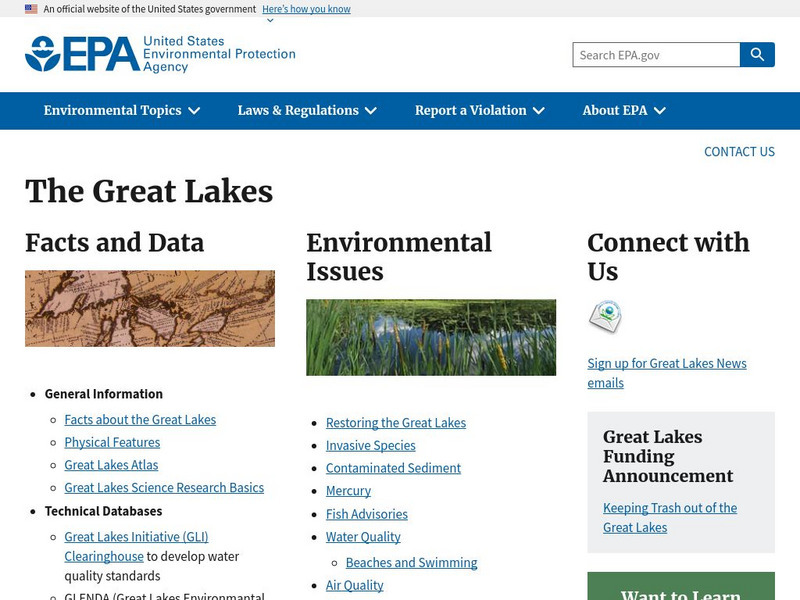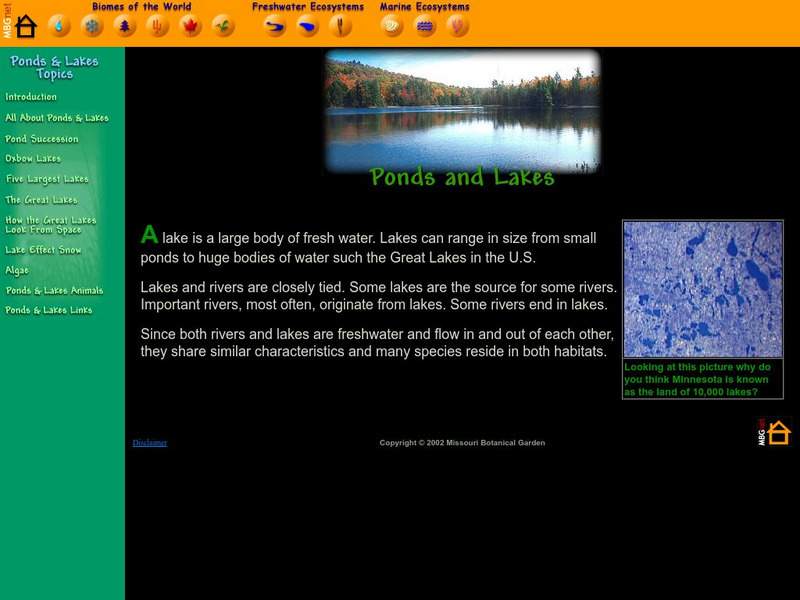Curated OER
Lesson Plan on the Edmund Fitzgerald
Fourth graders describe the weather conditions and location of the Edmund Fitzgerald when it sank in Lake Superior.
Curated OER
Lake Superior Ecology Unit
Sixth graders research Lake Superior and its ecosystem. Students investigate the lake's cycles of mixing and stratification and how these cycles affect the biology of the lake. This lesson plan contains five days of activities.
Curated OER
Bell Live! The Great Lakes: A Superior Adventure
Students participate in a virtual field trip to Lake Superior. In groups, they perform experiments in which test the level of toxins and bacteria in the water. They also watch video segments life in the lake and discuss their observations.
National Endowment for the Humanities
Neh: Edsit Ement: Anishinabe Ojibwe Chippewa: Culture
Though written for grades 3-5, this lesson plan can be easily changed to help students of all ages learn about the Chippewa people. Additional resources provide historical, cultural, and geographical facts concerning this Native American...
University of Chicago
American Environmental Photographs 1891 1936
An interesting site that shows early photographs by Henry Chandler Cowles and George Damon Fuller and others. The images range from ecological settings to the consequences of human changes to the environment.
US Environmental Protection Agency
Epa: Great Lakes
The EPA profiles the Great Lakes ecosystem, their ecological protection and restoration, wetlands, shorelands, pollution prevention, and so on. Click "Visualizing the Great Lakes" for pictures of the lake environment.
US Environmental Protection Agency
Epa: The Great Lakes
Learn about the Great Lakes by reading detailed facts and data about each of the five lakes. Presents information about management plans, environmental issues, and physical features.
Environmental Education for Kids
Eek!: Discover the Great Lakes
The Great Lakes include, Superior, Michigan, Huron, Erie and Ontario. These lakes form the largest fresh water system on earth and they are North America's greatest natural resource. Learn about the different lakes, how they formed,...
Environmental Education for Kids
Eek!: Lake Superior
This site provides facts, illustrations, and more about the largest Great Lake. Includes descriptions of wildlife and industry. For grades 4-8.
Missouri Botanical Garden
Missouri Botanical Garden: Lakes and Ponds
This illustrated website features facts about lakes and ponds and their special place in geography, natural history, and as a biome.
Other
History of Minnesota's Lake Superior
Track the history of exploration, settlement, fishing, and recreation on Lake Superior in this lengthy description of one of our Great Lakes.
US Geological Survey
Usgs: Earth's Water: Lakes and Reservoirs
The USGS reviews the differences between lakes and reservoirs. They discuss the history of freshwater and salt water lakes. Click Home to access the site in Spanish.
National Wildlife Federation
National Wildlife Federation: Great Lakes
Visit this resource to briefly explore the geography and history, meet the wildlife, and understand the threats to the Great Lakes basin.
University of Chicago
University of Chicago: The Great Lakes: Our Legacy, Our Future
This 2001 exhibit focused on the EPA's Great Lakes National Program Office's work to ensure the protection and restoration of the Great Lakes in the areas of chemical contamination and habitat loss.
Curated OER
Clip Art by Phillip Martin: The Great Lakes
Map highlighting the Great Lakes of North America.
Curated OER
Photo of Lake Superior
This site provides facts, illustrations, and more about the largest Great Lake. Includes descriptions of wildlife and industry. For grades 4-8.
Curated OER
Big Bay State Park Is Located in Lake Superior on Madeline Island
This site provides facts, illustrations, and more about the largest Great Lake. Includes descriptions of wildlife and industry. For grades 4-8.
Curated OER
Lake Superior Shoreline
This site provides facts, illustrations, and more about the largest Great Lake. Includes descriptions of wildlife and industry. For grades 4-8.











